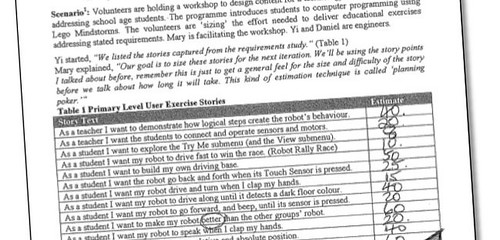Objectives
Understand the ‘planning poker’ technique for task/story estimation for high tech development project and to obtain useful estimates for (iteration) planning.
Prerequisites
Familiarisation with ‘user stories’ and the ‘story card’ method for capturing goal driven requirements.
Planning poker cards or index cards with range of numbers (?, 0, 1/2, 1, 2, 3, 5, 8, 13, 20, 40, 100, & coffee)
Instructions
Budget up to 45 minutes to run the whole exercise (for a class size of ~50). Arrange class into groups from 4 to 7 people.
- Allocate 1” for everyone to read through the ‘local’ rules for planning poker below.
- Discuss planning poker rules to clarify understanding.
- Allocate 2” for everyone to read the scenario carefully (don’t make personal estimates yet).
- 25” for planning poker rounds.
- 15” for debriefing discussion.
- The dealer picks up the next story and asks: “Ok, how many story points will this story take?”
- Team members think about the story and come up their own estimates. Nobody speaks the estimate just yet.
- Members place a card from their decks face down on the table, with a value equal to or close to their estimate.
- When everyone’s card is on the table turn the cards over at the same time.
- Each person explains what he or she thought the story required, maximum of 3 minutes discussion.
- Taking account of new information the cards are played again (and perhaps again) until rough convergence is achieved or one developer’s proposal and estimate is agreed upon.

Discussion points
- Did you identify duplicate entries?
- How did you handle user stories that did not follow the “As a… I want to… so that…” pattern?
- Were some user stories too ambiguous to estimate?
- How did the teams make sense of the stated requirement?
- Did the teams seek clarification from the product owner?
- How were divergent estimates treated?
- Describe your ‘feelings’ about the process? Fair, political, honest, dominated, contentious, accurate, shared, personalised, ideas, support, attack…
- How did the team arrive at a shared interpretation of the estimated value?
- Did you attach a concrete meaning for the estimate figure? Dimensionless, people, complex-standalone, similar to or like something else, hours, days, small-medium-large, easy-difficult…
Online version
The online version we'll use is courtesy of PlanningPoker.com's basic free account access.
 | |
| Register at https://play.planningpoker.com/plans and select the free account option |
Enter the following stories:
First a simple test run...
Organise a class night out under Covid
Title: Organise a class night out under CovidDescription: As a member of the class I want organise a social event for the whole class that is fun and interactive and accessible so that we (as a class) get to know each other better.Acceptance Criteria:It must...Involve the whole classConform with social distance normsBe funBe accessibleBe interactive
You provide a Wedding Planning Service
The couple wants you to plan and design a whole wedding experience.
How long will it take you to put together a proposal for the following...
- A wedding experience starting on Christmas Eve.
- Options for the perfect venue - a Castle in the West of Ireland.
- With accommodation and board for approximately 200 guests (around 150 arriving from abroad).
- Arranged airport to venue transportation.
- Providing three separate marriage celebration ceremonies running over three consecutive days, each in a different style: European, Asian, South American.
- Concluding with a morning reception on the last day.
- Offering high impact evening entertainment options.
- Provide Media Service and Management (socials, streaming, video, photography).
- Full Security offering.
- Provide optional sports and tourist activities over 3.5 days.
- Arranged airport transportation for departing guests.
Bridge Design Lesson Plans
- A. Five classic bridge designs
- B. Bridge failures!
- C. Test stuff to destruction!
Title: A. Five classic bridge designsDescription: As a teacher I want student groups to construct models of the 5 classic bridge designs so that they have practical hands-on experience of design construction challenges.Acceptance Criteria:Proposed lessons to be delivered in blocks of 45 mins for a sample group of students (teenagers).Student group completes lesson for bridge type 1 in 45 minsRepeat lessons for bridge types 2-5 each taking 45 mins.Photographic outputs from each lesson.Title: B. Bridge failures!Description: As a teacher I want students to test the weight bearing capacity of different bridge designs so that my students will appreciate the applications for different bridge types.Acceptance Criteria:A lesson plan for a 45 min classStudents to generate photographic evidence and scientific data relevant to bridge performance.Title: C. Test stuff to destruction!Description:As a teacher I want students to evaluate different building materials and relate them to physical design elements so that my students will appreciate the suitability of material choices for different bridge elements.Acceptance Criteria:Each proposed lesson to be delivered in blocks of 45 minsStudents to create a table of physical characteristicsStudents to create a table of load characteristicsStudents to create analytical maps of physical demands for bridge design elements
Cohn, M. (2006) Agile Estimating and Planning, Upper Saddle River, NJ, Pearson Education.



